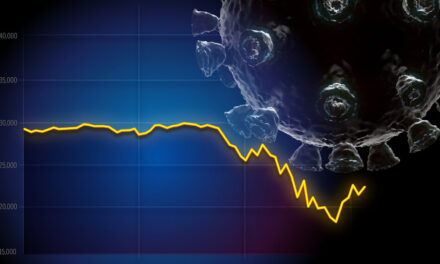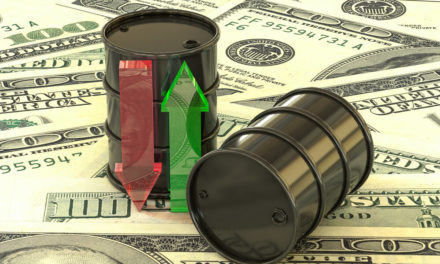The longer the hit, the bigger the bill, the greater the central bank stimulus will have to be to keep the debts affordable.
After weeks of relative optimism in financial markets about a reopening of frozen economies, effectively shut for months to contain the pandemic, a dark cloud has descended once again over the investment outlook.
Federal Reserve Chair Jerome Powell’s gloomy economic prognosis on Wednesday — an “extended period” of slow growth and need for more fiscal and monetary help — was just the culmination of a rethink within the financial world.
As Powell spoke, IMF Chief Economist Gita Gopinath flagged another downgrade of the International Monetary Fund’s already dire prediction of a 3% contraction of the world economy this year. Citing a deeper collapse in consumption than previously thought, she warned: “It looks as if the outlook will worsen.”
Even China, which was first to force coronavirus-related lockdowns and emerged earlier than other major economies, has no end in sight. Finance Minister Liu Kun wrote in Thursday’s official People’s Daily that “downward pressure on the economy is still increasing.”
Global stock markets, which had recovered about half their initial pandemic-related plunge through April, are reevaluating the situation too. After sidewinding through the first half of May, they now look to be drifting into a relapse of sorts. Eurozone bank stocks on Thursday sounded a klaxon and breached the March low to set new records more than 50% below peaks before the pandemic, and U.S. peers are close behind.
Not only do first-half economic soundings look harsher than initial forecasts, investors are also coming to grips with the prospect of only phased easing of lockdowns that mean many economies face restrictions on movement and travel through the third quarter at least — with public confidence and consumption likely dented well beyond that, if surveys are to be believed.
And even if forecasts are largely finger-in-the wind for now, economic surprise indexes measuring incoming data against consensus expectations are their most negative since 2008. What’s more, global corporate earnings forecasts for 2020 have dropped to -16.2% from -5.7% in just one month and may have to fall further if revisions around the 2008 crash are any guide.
Hopes for a “game-changing” medical breakthrough in treatments or a vaccine later this year remain just that. The European Medicines Agency said on Thursday a vaccine could be approved in about 12 months’ time in an “optimistic” scenario.
“We have become increasingly gloomier on the global economy,” Deutsche Bank’s chief economist David Folkerts-Landau told clients on Tuesday while downgrading the bank’s global economic forecast to show a whopping 5.9% contraction of output for 2020 – almost twice the standing IMF forecast.
Folkerts-Landau wrote that without a vaccine, which Deutsche sees as unlikely this year, the world would need to get used to a long period of social distancing – with huge economic and social implications. And if the recovery doesn’t begin in Q3 as Deutsche expects, it fears world equities could recoil to some 5% below the March lows.
“A highly uncertain and worrying outlook lies ahead, and it is likely that any short-term stability will come at a huge long-term cost,” he added. “This crisis is also going to permanently scar government balance sheets, with wartime level deficits likely across the board.”
Why so Surprised?
Stock markets have no shortage of reasons to fret — downward earnings revisions, banks with mounting bad loans, corporate cashflow freezes, bankruptcies and bailouts, dividend cuts, a hiatus in stock buybacks. Add to that fresh U.S.-China trade and political tensions, uncertainties surrounding the U.S. election in November, fears of eurozone fragmentation and even Brexit.
To date, massive central bank and government support has largely offset the pandemic shock to financial markets — stabilizing credit markets at least, preventing illiquidity morphing into insolvencies for now and directly replacing lost household income in some cases. Huge rebounds in already leading sectors that actually benefit from the shock — technology and pharmaceuticals for example — also flattered the wider rebound in the six weeks through May.
But if we now have to brace for a longer and deeper economic hit, government support will need to be extended — as stressed by Powell yesterday as well as several European Central Bank and Bank of England officials over the past week.
But even if governments are forced to do even more heavy-lifting via fiscal levers, sovereign debt loads already projected to soar above 100% of annual output over the coming year will only have to rise further, and persistent central bank support will be needed to keep them sustainable over time.
One of the lessons learned after the last financial crash was that countries that rushed to rein in bloated debts via austerity policies of spending cuts and tax rises were doomed to years of mediocre recoveries and political backlashes in some cases.
The more likely alternative this time around — much like policies adopted after World War II — will be for central banks to keep the cost of those debts manageable.
If not the negative interest rates already in the eurozone, Japan, Switzerland and elsewhere, then negative real interest rates over time in the bond markets via bond-buying, yield curve control and policy rates near zero for another decade or more.
© Copyright Thomson Reuters 2020.




